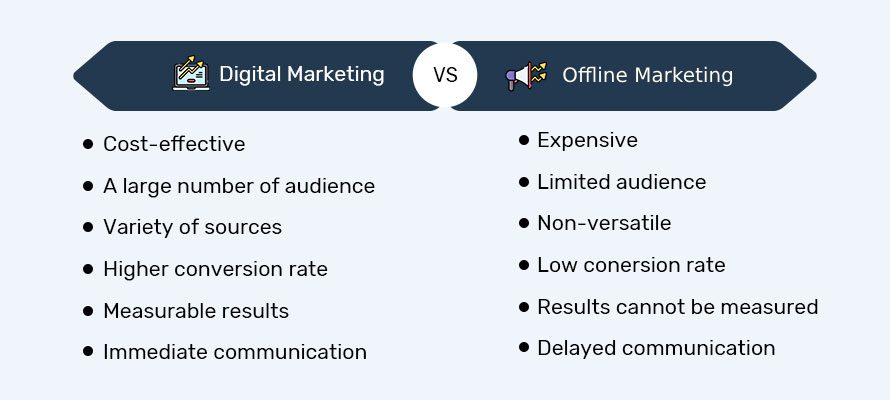Introduction
Marketing has evolved significantly in recent years, thanks to the digital revolution. However, traditional offline marketing methods remain relevant and effective for many businesses. To make the right decision, let’s first understand the core differences between offline marketing and digital marketing.
Offline Marketing
Offline marketing, also known as traditional marketing, encompasses a range of promotional activities conducted through non-digital media channels. Here are some key characteristics of offline marketing:
Tangible Presence: Offline marketing strategies often involve physical materials such as brochures, flyers, business cards, billboards, and print ads. These tangible items can leave a lasting impression on your audience.
Local Focus: Offline marketing typically targets a local or regional audience. It’s highly effective for brick-and-mortar businesses aiming to attract nearby customers.
In-Person Engagement: Face-to-face interactions, trade shows, and networking events enable businesses to establish personal connections with potential customers.
Longevity: Offline marketing materials can have a longer lifespan. For instance, a well-designed brochure can remain on a desk or bulletin board for weeks or even months.
Advantages of offline marketing
What are some of the benefits of offline marketing?
There are a lot of benefits of offline marketing, but one of the most important is that it’s much easier to get people to convert. With people receiving your ads in many different mediums, you’re able to increase your customer base substantially.
Customers are truly able to experience your products in person with the help of virtual reality.
We’re bringing brands and businesses together so they can bring their products and services to customers who are more than willing to try them.
Offline marketing has not just helped the new generation of customers, but also the older generation of customers can be reached out.
The internet is being used by people from both of these generations. More importantly, offline marketing allows for personal in-person interactions which can make a huge difference in driving sales to your company for both generations.
The company can advertise to the customer in many different ways.
When a customer is watching television, looking at billboards or reading the newspaper, they might not even notice the ad and still come across it. If they don’t see it on TV, they’ll still hear it on the radio, or even read an advert in a magazine.
Disadvantages of Offline Marketing
What are the disadvantages of offline marketing?
In the offline marketing, advertising costs a lot. This is because one simply has to advertise on one platform but many. They have to advertise on television, radio, and print media, as well as through billboards. All of this will require spending a lot of money–a significant expense for any business owner looking to advertise in this method.
Another disadvantage with this process is the amount of time it takes to design, print and distribute. It can be tricky to advertise in a lot of places, as well.
Companies often run into problems when it comes to tracking the outcomes of offline marketing. Since these attempts generally involve using tools like physical flyers, coupons and advertisements, it becomes difficult to know exactly how many customers are being reached and how many aren’t.
With offline marketing, there are many benefits. For example, it is possible to reach people who don’t have an internet connection. One of the drawbacks is that the reachability is limited due to the cost factor. For example, if a company has more money they can better afford to invest in advertising than if a small company doesn’t have as much money to afford additional costs.

Digital Marketing
Digital marketing leverages online platforms and channels to connect with a global audience. Here are some key characteristics of digital marketing:
Global Reach: Digital marketing allows businesses to reach a vast and diverse audience worldwide, making it ideal for online businesses and those targeting a broader customer base.
Real-time Analytics: Digital marketing provides access to real-time data and analytics, allowing businesses to measure the effectiveness of their campaigns and make data-driven adjustments on the fly.
Cost-Efficiency: Compared to offline marketing, digital marketing is often more cost-effective. You can allocate your budget more efficiently and track your return on investment (ROI) more precisely.
Targeted Advertising: Digital marketing offers advanced targeting options. You can reach specific demographics, interests, and behaviors, increasing the chances of converting leads into customers.
Advantages of digital marketing
The main advantage of digital marketing is that a targeted audience can be reached in a cost-effective and measurable way. Other digital marketing advantages include increasing brand loyalty and driving online sales.
The benefits of digital marketing include:
Global reach
A website allows you to find new markets and trade globally for only a small investment.
Lower cost
A properly planned and well-targeted digital marketing campaign can reach the right customers at a much lower cost than traditional marketing methods.
Trackable, measurable results
Measuring your online marketing with web analytics and other online metric tools makes it easier to establish how effective your campaign has been. You can obtain detailed information about how customers use your website or respond to your advertising.
Personalization
If your customer database is linked to your website, then whenever someone visits the site, you can greet them with targeted offers. The more they buy from you, the more you can refine your customer profile and market effectively to them.
Openness
By getting involved with social media and managing it carefully, you can build customer loyalty and create a reputation for being easy to engage with.
Social currency
Digital marketing lets you create engaging campaigns using content marketing tactics. This content (images, videos, articles) can gain social currency – being passed from user to user and becoming viral.
Improved conversion rates
If you have a website, then your customers are only ever a few clicks away from making a purchase. Unlike other media which require people to get up and make a phone call, or go to a shop, digital marketing can be seamless and immediate.
Disadvantages of digital marketing
Downsides and challenges of digital marketing
Skills and training
You will need to ensure that your staff have the right knowledge and expertise to carry out digital marketing with success. Tools, platforms and trends change rapidly and it’s vital that you keep up-to-date.
Time consuming
Tasks such as optimizing online advertising campaigns and creating marketing content can take up a lot of time. It’s important to measure your results to ensure a return-on-investment.
High competition
While you can reach a global audience with digital marketing, you are also up against global competition. It can be a challenge to stand out against competitors and to grab attention among the many messages aimed at consumers online.
Complaints and feedback
Any negative feedback or criticism of your brand is can be visible to your audience through social media and review websites. Carrying out effective customer service online can be challenging. Negative comments or failure to respond effectively can damage your brand reputation.
Security and privacy issues
There are a number of legal considerations around collecting and using customer data for digital marketing purposes. Take care to comply with the rules regarding privacy and data protection.
Conclusion
In the battle of offline marketing vs. digital marketing, there is no one-size-fits-all answer. The best approach depends on your business’s unique characteristics, goals, and target audience.
Consider your audience’s online behavior. If they are active on social media, engage with online content, or frequently shop online, digital marketing may be the way to go. For businesses with a strong local presence or those catering to an older demographic less active online, offline marketing can still yield impressive results.
In many cases, a well-balanced marketing strategy that incorporates both offline and digital elements can be the most effective. They can complement each other, reinforcing your brand message across various touchpoints.
Ultimately, the choice between offline and digital marketing should align with your business objectives and resources. Keep in mind that marketing is an ever-evolving field, so regularly reassess your strategies to stay ahead in the competitive landscape. By understanding the nuances of both offline and digital marketing, you’ll be better equipped to navigate the dynamic world of marketing and make choices that drive your business toward success







